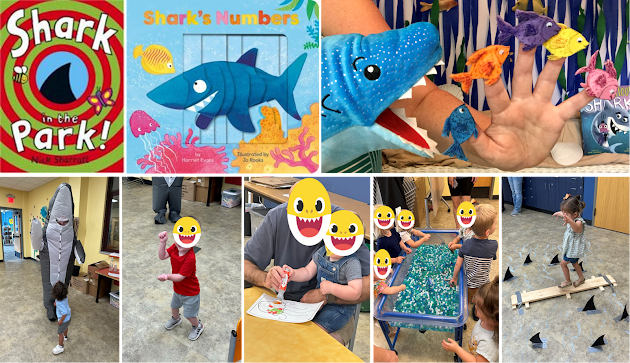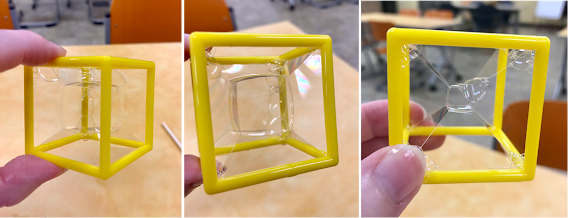Although I'm not particularly crazy about or interested in sharks, I did used to enjoy Discovery Shark Week back when it was still educational and not sensationalized crap, and I discovered when I did my very first Shark-themed storytime that it does make for some great programming. Last summer we did a whole week, and it was so fun and such a hit that we did the same this year, and for the first time in a while it luckily coincided with the Discovery channel Shark Week.
I had the following shark-themed programs and passive activities (programs described below, with photos):
- Display of shark & other ocean-related books
- Scavenger hunt & coloring sheets
- Family Storytime
- Elementary Explorers (ages 6-10)
- Tween/Teen Shark Tooth Necklaces (ages 11-18)
- Newport Aquarium with Live Shark (all ages, best suited for ages 8 & up)
Family Storytime
We sang "Slippery Fish", did "Two Little White Sharks" (modeled after "Two Little Blackbirds") with finger puppets, "Five Little Fishies Teasing Mr. Shark" with puppets, and read Shark In The Park (now available in boardbook, but I sure wish they would re-release in hardback!) by Nick Sharratt and Shark's Numbers by Harriet Evans. Afterward, we had a visit from Mr. Shark (a coworker in an inflatable shark constume), and I had a few activities: sensory bin with water beads and toy sharks, dot painting sharks & other ocean creatures, and walking the plank (balance beam) over shark-infested waters (cardstock fins taped to floor with waves drawn using chalk). The kids (and grown-ups!) had a blast.
Elementary Explorers
This is the one I really wanted to highlight here, because it was SO easy and so much fun! It turned out to be my favorite program of the week. Knowing this would be the last week of summer and I would be running on fumes, I took the easy way out and ordered these cute "Pet Shark-in-a-Jar" kits from OT. They were a bit pricey ($2.84/ea), but so cute!
I first booktalked a few shark-themed books, both fiction and non-fiction, then showed a short slide show with pictures and a few facts of around 8 of the more unusual shark species. I followed that with a brief shark trivia quiz. Then we began working on our pet sharks in jars. I supplemented what came in the kits with sand and some tiny shells I had leftover from making beach slime last summer, which really added a nice touch. I also offered shark origami corner bookmarks as an additional craft, with printed step-by-step instructions with photos and a QR link to video instructions. While they worked on their crafts I entertained/annoyed them with corny shark jokes. That morning before work a "What Shark Species Are You" quiz coincidentally (or not) showed up in my Facebook feed. I wasn't sure if the kids would be interested, but they loved it! As they finished up their crafts, they would come up one at a time, and I'd help them go through the quiz, then take their picture next to the TV screen with their result.
I didn't have a huge turnout, as our numbers always drop by the last week, but it was nice have a smaller group for a change, more relaxed and calm, and those that came really enjoyed it. I was surprised at how much they liked the "What Shark Species Are You" quiz; one boy even made both his grandparents come in and take it, LOL!
Tweens & Teens
Another easy program, making shark's tooth necklaces using waxed braided cotton cording, wooden beads, and pre-wired shark teeth. I did this same activity last summer with the younger kids, and it was a hit with all ages. I noticed a few kids wearing their necklaces the next day.
Newport Aquarium - Sharks!
The week culminated with a shark program by the aquarium, complete with a live shark! I was a little hesitant to book them, because at a previous job when a coworker booked them we expected 200 people, and ended up with at least 600 and had to turn many away! I did advanced ticketing, with 125 tickets (the limit set by the aquarium) made available to be picked up started the Saturday before the program. Almost 90 tickets were given out that first day, with the last 37 going out Monday morning. We had about 20 no-shows, and 2-3 walk-in families we were then able to accommodate, so it worked out just right!
Next year I'm going to have them bring sting rays!
And with that, my summer is done, other than doing the prize drawings and putting together some stats and a highlight video. I'm doing storytimes this week, then going on vacation and taking a programming break for the rest of August!
















.jpeg)



